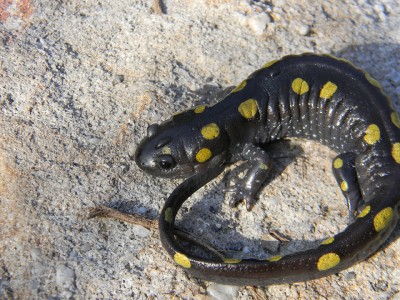It’s that time of year again—the time of the salamander migration.
A few nights ago, after a heavy rain, I ventured out to find some friendly amphibians. Walking hunched over around a vernal pool, I suddenly saw one. My flashlight caught the glimmer of a beautiful spotted salamander.
These amphibians are striking in size and color. Their yellow spots and bluish black body set them apart from other salamanders. They can reach up to nine inches in length from mouth to tail—which makes them one of the biggest salamanders in PA. The spotted salamander lives throughout the Eastern United States and spends most of its time hidden in low lying forests snuggled up under rocks or logs. They will emerge at night in order to hunt their prey: spiders, worms, and other small insects. However, once the first spring rain occurs, they begin to come out of the forest in order to mate. They can travel a surprisingly far distance across land in order to reach vernal pools to lay their eggs.
Unlike ponds, vernal pools are temporary pools filled by surface runoff and snow melt that dry up for part of the year. These pools provide a perfect mating ground for the spotted salamanders because they are void of predatory fish. Amphibians like spotted salamanders will travel, oftentimes via the same route, to the same vernal pool, spring after spring, to mate. Now is the perfect time to head out to low-lying wetlands or roads near water to find these spotted salamanders. Remember to bring a flashlight because the salamanders move at night!
Thanks to all of our visitors who joined Dr. Jim Julian and Jerod Skebo for our public vernal pool walk recently! Stay tuned for more public programs, including soapmaking, primitive fire making, and the annual Native Plant Festival and Birding Cup.


